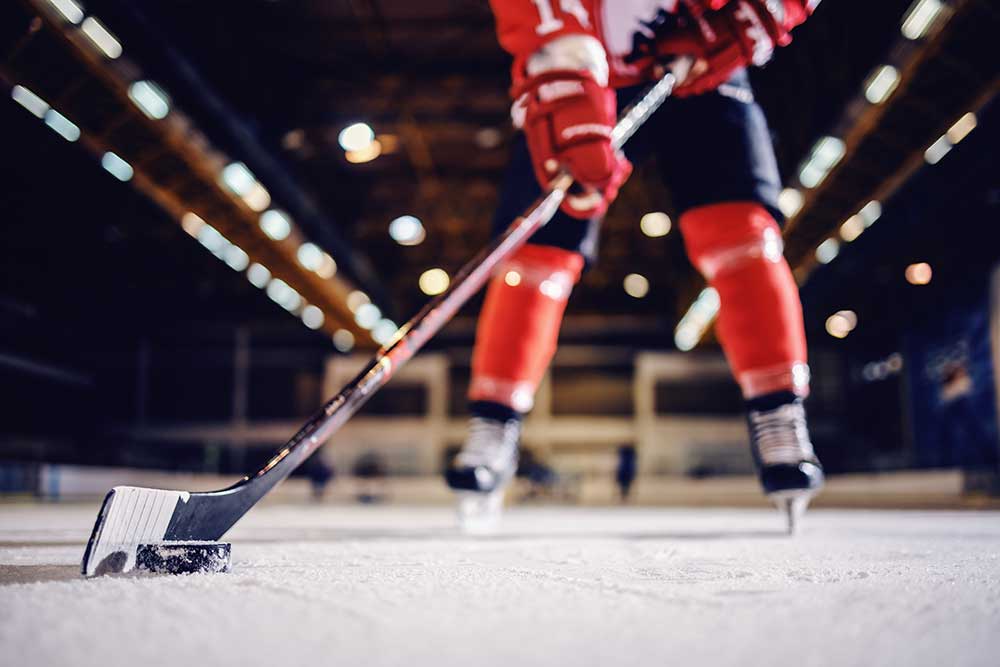
From pro and semi-pro, to collegiate, juniors, youth, peewee and pick-up players, ice hockey is a popular winter sport. There is high speed action. Impacts and collisions can lead to injury in ice hockey players.
What are the common risks for injury in ice hockey players?
Richard Cunningham, MD, is a board certified orthopedic surgeon and sports medicine specialist, with a focus on the diagnosis and treatment of both shoulder and knee injuries. Ice hockey injuries often occur to the shoulder or knee. Dr. Cunningham has worked extensively with hockey athletes of all levels.
Ice hockey injuries are due to:
- Speed of the game; skating 20-30 mph is not unusual in professional play
- High energy collisions with other players
- Puck speed averaging 80-90 mph, with bursts well above 100 mph
- High speed collisions with objects, including goal posts, boards, hockey sticks and skate blades
- Non-stop action, resulting in fatigue making one more vulnerable
Other contributing factors include inadequate protective equipment and illegal physical contact, such as cross checking. Utilizing the proper equipment, maintaining good fitness, and having referees that enforce the rules of the game can help prevent injury.
What injuries are most common in ice hockey players?
The speed, power, and dexterity that make a hockey player great also contribute to the injury patterns that are commonly seen in the sport. 4 of the top 5 most frequent injuries involve the shoulder or knee. Common hockey injuries include:
Separation of the acromioclavicular joint (AC) – The AC joint is where the clavicle and scapula connect. The AC joint ligaments can be torn and disrupted by a blow to the front or top of the shoulder as when falling onto the shoulder and striking the boards. Patients experience pain on the top of the shoulder and often notice swelling and a bump in this area. AC joint separations are graded on a 1-6 scale in terms of severity. The higher the grade, the more serious the disruption to the AC joint. Low grade separations are treated non-operatively with a sling and physical therapy. Higher grade separations require surgery in order to have a full recovery.
Shoulder dislocations – Collisions and falls can cause shoulder dislocations. The top of the arm, known as the humeral head, is forced out of the shoulder socket, known as the glenoid. Most dislocations are anterior, where the head comes out the front of the socket. Posterior dislocations are less common. Most acute dislocations require medical attention to confirm the diagnosis and have the shoulder joint relocated. First time dislocations often do not require surgery, but recurrent shoulder dislocations are often treated with shoulder stabilization surgery.
Fracture of the clavicle – Also known as a broken collarbone, this common ice hockey injury occurs with a high energy fall on the shoulder or a direct blow to the relatively thin clavicle bone. Players will experience pain, swelling, and limited arm motion, as well as a grinding sensation and usually a disruption of the clavicle’s natural contour.
Medial Cruciate Ligament (MCL) tears of the knee – In ice hockey players, the MCL, the ligament supporting the inside aspect of the knee, is at risk for injury. There are two frequent causes:
- The typical push-off movement, when starting or accelerating a glide, can generate excessive force to the MCL and sprain it or partially tear it.
- The second is a collision with a blow to the outside of the knee, where the knee caves inward, causing a tear to the MCL.
There are other hockey injuries that include concussions, hand, ankle and hip injuries, contusions, lacerations and dental injuries. Dr. Cunningham can diagnose and treat the injury, and return a player to the ice as soon as possible.
Ice Hockey Injury Prevention Strategies
Two areas of prevention provide the best protection for players. These include safety protocols, and player training and conditioning.
Safety Protocols
- Annual medical exam for players
- Access to sports medicine specialists for training and injury management.
- Access to and use of proper fitting protective equipment including breezers, facial protection, helmets, shoulder pads and gloves
- Dedicated enforcement of safety and game rules
- Proactive, professional and fair refereeing, including zero tolerance for illegal hits
Player training is also essential to decreasing risk of injury. Best practices include:
- Training for strength, stamina, agility and aerobic conditioning
- Use of a sports medicine specialist for optimal body mechanics development
- Maintenance warm-up, cool down and stretching routines
- Proper nutrition, hydration and sleep
- Correct use of proper equipment during training and scrimmages
- Balance training, both on and off the ice
- Increase of upper body strength and agility
- Explosive leg strength training
Dr. Richard Cunningham and his expert care team are your go to provider for all of your injury prevention training information. Contact us today at 970-569-3240.
